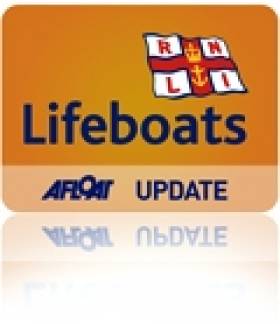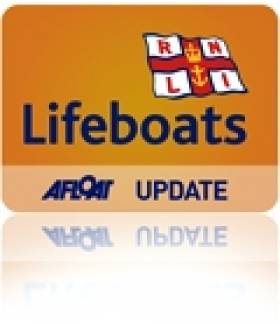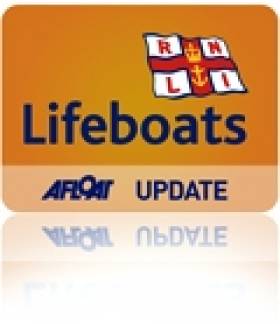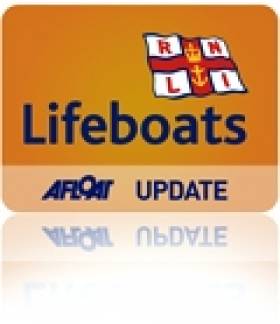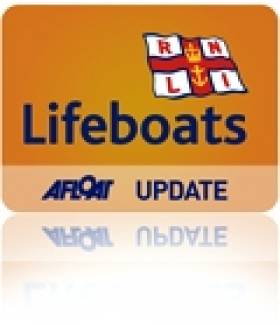Displaying items by tag: Wicklow
Wicklow Lifeboats Rescue Five From Grounded Vessel
#RNLI - Both Wicklow RNLI lifeboats launched after 4.15pm yesterday afternoon (Thursday 24 July) to assist a vessel aground near Travelahawk beach south of Wicklow Harbour.
The alarm was raised after the owner of a motor boat put out a distress call on marine VHF radio to say his vessel was aground on rocks and they required assistance.
The inshore and all-weather lifeboats were on scene minutes later and found there were two boats aground.
A lifeboat crew member was transferred onto the boats from the inshore lifeboat to assist with rigging tow lines. The inshore lifeboat then towed a small hire boat with three occupants off the rocks and brought them to safety at Wicklow Harbour.
The larger motor boat was successfully refloated by the all-weather lifeboat crew and towed into Wicklow Harbour, where its two passengers were landed safely at the East Pier.
Wicklow Inshore Lifeboat Rescues Sheep Trapped In Cave
#RNLI - Wicklow RNLI's inshore lifeboat launched at 3pm on Wednesday afternoon (23 July) to rescue a sheep trapped in a cave and in danger of drowning as the tide rose.
Two attempts had already been made to recover the sheep by its farmer, but he was unable to get down the rocks safely, so the lifeboat crew were asked if they could help.
The inshore lifeboat was on scene at 3.35pm at Mizen Head, south of Brittas Bay beach, where the crew successfully retrieved the animal from the cave.
The frightened but uninjured sheep was reunited with its owner a short time later on a nearby beach.
The lifeboat crew on this callout were helm Alan Gouche, Lisa O'Leary and Graham Fitzgerald.
Howth, Wicklow Lifeboats Aid Vessels With Engine Troubles
#RNLI - Howth RNLI continued a busy week of callouts on Wednesday evening (16 July) when the volunteer crew launched to assist a 27ft motorboat with no power drifting in the vicinity of the Nose of Howth.
The crew was alerted at 6.43pm following a distress call that a motorboat with two crew members aboard was drifting with no engine power at the mercy of the strong tide.
Weather conditions at the time were very good, with a light westerly Force 2 to 3 breeze and good visibility.
The Howth lifeboat, under coxswain Fred Connolly and with five other crew members on board, quickly located the casualty vessel and established a tow line to return the vessel and its occupants to the safety of Howth Harbour exactly an hour after the initial alert.
"The crew of the motorboat did the correct thing to call for help as soon as their vessel experienced engine trouble," said Connolly. "We are pleased that we were able to locate and tow the vessel to safety before it drifted closer to the shore."
Later that evening, Wicklow RNLI launched its all-weather lifeboat Annie Blaker to go to the aid of a 24ft yacht with mechanical problems off the Wicklow Coast.
The alarm was raised after the boat on passage south developed engine problems, With light wind, the yacht was unable to make any headway under sail, so the crew dropped anchor and contacted the Irish Coast Guard for assistance.
Wicklow's lifeboat, under the command of coxswain Nick Keogh, located the yacht – with two adults and a dog on board – one mile east of the Six Mile Point at 11.54pm. Conditions in the area were calm sea and light wind.
Crew member Kevin Rahill was transferred onto the yacht to establish a towline and assist the two sailors. Once the towline was rigged, the yacht was towed back to Wicklow Harbour, where it was safely secured alongside the East Pier by 1am.
Round Ireland Yacht Race 2014 - The Fat Lady Sings
#roundireland14 – Can there be any ocean race of similar length that offers intrigue, excitement, drama, joy and despair to the same extent that the Round Ireland does?
What about the tight finish that saw only 7 minutes separating winner Tanit from Ruth in second place. How about Cavatina, much fancied before and after the start, on the water leader for 450 miles before fickle winds relegated her to a finish outside the top five. Think of the cruel luck of Amazing Grace, valiantly fighting back after a start line collision that cost her two hours of actual time and at least three more from missing the tide, only to break her boom when she had largely eliminated the deficit.
After recognising the great achievement of Richard Harris’ Clyde based Sydney 36 Tanit, much sympathy is reserved for Liam Shanahan and crew aboard the J109 Ruth. On Thursday morning we said “With only 45 miles to go at 4am, the forecast suggests that Ruth will enjoy a fairly steady breeze of medium strength for the final fetch to the finish.” Talk about putting the mockers on it! 4 hours later the wheels came off Ruth’s wagon and it took her 4.5 hours to cover 10 miles as the wind fell away. She still made a valiant effort to get across the line, missing out on overall honours by just 7 minutes after 5 days of racing.
Congratulations Tanit, deserved winners of the 2014 Round Ireland Yacht Race.
For those of us living the race vicariously, the Yellowbrick tracker has contributed enormously to our enjoyment so kudos to Wicklow Sailing Club and the RORC for its supply. Roll on 2016!
Wicklow RNLI Lifeboat Assists Four People in Difficulty at Silver Strand Beach In One Afternoon
#RNLI – Wicklow RNLI all weather and inshore lifeboats launched this afternoon (Wednesday 2 July 2014) to three incidents involving four people on Silver Strand beach in Wicklow. The alarm was raised initially for a woman who was spotted in difficulty in the water and who had been swept into a cave. This was followed, with the assistance of the Coast Guard Helicopter, by the rescue of two people who had become injured on rocks and needed medical attention. The lifeboat crew were then called on to assist a woman on the beach who had become unwell.
The Wicklow RNLI lifeboats launched at 3.39pm this afternoon to a report of a woman in difficultly in the water at Silver Strand beach, one mile south of Wicklow Head. The Wicklow inshore lifeboat crew found it difficult to locate the casualty and following a search with help from a member of the public on the shore, the lifeboat crew found the woman at the rear of a cave close to the beach. A crewmember then entered the water and swam into the cave to assist the woman. He placed her in a lifejacket before assisting her from the cave to the waiting inshore lifeboat and the crew started to administer first aid, as she was showing signs of hypothermia. They then transferred the casualty to the all weather lifeboat a short distance away, which returned to the shore and was met by an ambulance.
The inshore lifeboat returned to the area and the volunteer crew was informed that two people who had earlier tried to assist the first casualty had injured themselves on rocks while trying to return to the beach. They also requested the all weather lifeboat to return to the scene and the lifeboat crew began to administer first aid. They were joined on scene by the Dublin Coast Guard helicopter and the two people were winched on-board and taken to hospital.
While returning to the inshore lifeboat a crew member was made aware of a further person who needed assistance after they became unwell following their attempt to go to also go to the aid of the first casualty. Due to the lack of access for an ambulance the Coxswain requested the casualty be transferred by lifeboat and was taken ashore and met by ambulance.
.
Commenting on the day's events Wicklow RNLI Lifeboat Operations Manager Des Davitt said, 'This was an extremely busy afternoon for the lifeboat crew. What started as a callout to assist one person in trouble turned into a series of events which led to four people needing urgent attention.
It is very easy for people to get themselves into difficulty while they are at the beach and the rescue services are trained and available to deal with these situations. .
Both the RNLI and the Coast Guard helicopter responded to today's callout and ensured that the group were brought to safety and seen immediately for medical treatment.'
Busy Weekend For Wicklow Lifeboats
#RNLI - Wicklow RNLI's volunteers had a busy weekend answering three calls for assistance in a 24-hour period.
The first callout was on Saturday afternoon (28 June) at the start of the Round Ireland Yacht Race in Wicklow Bay when a competing yacht reported it was taking on water after sustaining damage on the race start line.
The lifeboat, under the command of coxswain Nick Keogh, and the inshore lifeboat escorted the 37-foot yacht with six crew safely into Wicklow Harbour.
The second callout came on Sunday morning (29 June) when both lifeboats were launched shortly before 8.30am to investigate a report of an injured man near Bride's Head.
The inshore lifeboat crew were on scene eight minutes later and found an injured man on a beach near Bride's Head. First aid was administered to the casualty after he sustained leg injuries from a fall off nearby cliffs.
The man was taken off the beach on the inshore lifeboat, transferred to the all-weather lifeboat and taken back to Wicklow Harbour. The lifeboat, under the command of Second Coxswain Ciaran Doyle, was met on arrival by a waiting ambulance crew at the East Pier.
Speaking following the callout, Wicklow RNLI press officer Tommy Dover said: "The casualty was extremely lucky and did not sustain any life-threatening injuries after his ordeal."
The third callout occurred on Sunday afternoon near the entrance to Wicklow Harbour, when the inshore lifeboat came to the assistance of a small boat with engine failure.
Helm Mark Kavanagh and two crew brought the boat with one person on board safely ashore.
#RoundIreland - The 18th Round Ireland Yacht Race got off to a dramatic start under a tight fetch from Wicklow today (28 June), with the local Volvo 70 entry outdone by the Teng Tools/Kilculllen Kapital Open 60 streaking into a lead as the biggest boats in the 36-boat fleet passed Wicklow Head.
But it looks like one leading contender for overall honours might be out if the race already after a startling line collision forced him to head back to Harbour.
The Dun Laoghaire to Dingle race champion Amazing Grace from Tralee Bay reported to the race committee that she was taking on water.
She also indicated she would be making a protest against another competitor, Lynx Clipper, which said she will be lodging her own protest over the same alleged incident.
The start was won emphatically by the Open 60, hitting the line at precisely the right moment, prompting some on the shoreline to query if she had been over the line. No chance. This was precision sailing, the Tengtools crew enjoying a clear run at least three boat lengths ahead of their nearest competitor, the Volvo 70.
By contrast, the smallest boat in the fleet, a 30-footer from Antrim, was battling big seas chopped up in the wake of the big boats departing Wicklow.
Winds dropped significantly as the fleet hoisted kites at Wicklow Head, and there were near perfect sailing conditions off the Wicklow coast of 12-15-knot winds from the north east, bright sunshine and a choppy sea state.
The 36-boat fleet cleared Wicklow Bay and Wicklow Head Lighthouse under a two-knot ebb tide, pushing them down along the Wexford coastline.
However, the fleet are expected to have lighter conditions tonight as they approach Tuskar Rock.
The 700-mile race is anticipated to take up to five days to complete, with the biggest boats expected home as early as Tuesday 1 July.
Early leaders – The Open 60 and Volvo 70 streak ahead at Wicklow
Wicklow Lifeboat Launches To Fishing Vessel
#RNLI - The Wicklow lifeboat launched shortly after 10.30am yesterday morning (Friday 30 May) to assist a fishing vessel 13 miles off Wicklow harbour.
The 13-metre vessel was fishing for whelk when a rope fouled its propeller and it was unable to make any headway.
The lifeboat reached the casualty at noon and the fishing vessel was taken in tow back to Wicklow Harbour, where a diver was waiting to clear the rope fouled propeller.
Speaking after the callout, Wicklow RNLI coxswain Nick Keogh said: "We located the fishing vessel with three crew about four miles north of the South Codling Buoy.
"Conditions in the area were good with sea state calm and a north westerly wind Force 3."
The crew on the callout were coxswain Nick Keogh, mechanic Brendan Copeland and crew Ciaran Doyle, Carol Flahive, Brendan Kavanagh, Tommy Murphy, Graham Fitzgerald and John Vize.
#RNLI - Wicklow RNLI launched to assist a yacht in difficulty before 10am yesterday morning (Sunday 11 May) just as lifeboat volunteers were preparing to launch on a crew exercise in Wicklow Bay.
The call for assistance from the yacht with three people on board was received by the Irish Coast Guard, who tasked Wicklow RNLI to the scene.
Both of the station’s lifeboats were immediately launched to attend to the 27-foot yacht, which was located one mile south of Wicklow Head.
The yacht’s tiller had snapped and the crew had lost all steering control. Conditions in the area were moderately windy, with a westerly Force 4 in moderate seas.
Lifeboat crew members John Vize and Paul Sillery were put on the yacht to assist with establishing a towline. Once this was completed, the vessel was taken in tow by the all-weather lifeboat.
With no tiller on the yacht the tow back to Wicklow was slow; a drogue was rigged to assist with the progress.
The lifeboat arrived back in the harbour at 12.10pm and the yacht with three crew was secured safely alongside the East Pier.
The crew on the all-weather lifeboat were coxswain Ciaran Doyle, mechanic Brendan Copeland, Carol Flahive, Connie O’Gara, John Vize and Alan Goucher. The inshore lifeboat crew were helm Mark Kavanagh, Paul Sillery and Matt Doyle.
Wicklow Lifeboat Tows Cabin Cruiser To Safety
#RNLI - Wicklow RNLI's second call-out this bank holiday weekend – after Friday's early morning tow of a stricken yacht - saw two on board a 13m cruiser brought to safety early today (4 May) after their vessel suffered engine failure.
The station's all-weather lifeboat was launched at 6.44am and located the vessel a short time later, two miles east of Wicklow Harbour.
Volunteer crew member Terry Sillery went on board the motor cruiser to assist with establishing a towline.
Weather conditions in the area at the time were blowing a westerly force three wind and there was poor visibility.
The motor cruiser was on passage to Wales when it developed engine trouble. The owner put down an anchor so the vessel would not drift and contacted the Irish Coast Guard for assistance.
The stricken motor cruiser was towed into Wicklow Harbour and safety secured alongside the East Pier at 7.40am.
The crew on the call-out were coxswain Dave O'Leary, mechanic Tommy Murphy, Terry Sillery, Carol Flahive, Brian Sinnott, Connie O'Gara, John Vize and Alan Goucher.


























